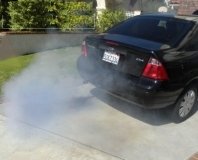I live in Wisconsin where they throw a pound of road salt on an ounce of snow, but my daily driver is a rusty trusty '88 Grand Caravan that refuses to break down. It's probably the last one left in the state. There's well over 400,000 miles on the engine. I regularly drag around a tandem axle enclosed trailer that's bigger than the van, and the transmission fluid and filter have been replaced once since the van was new. I haven't changed the oil in over ten years, (about 90,000 miles). I have to add a quart about every 800 - 1000 miles, so there is always some fresh additives going in that's in that oil. Obviously I'm not suggesting you or anyone else do that. That's not neglect; it's abuse, but I did it to show my students what some engines are capable of.
Given the miles and the rust, my van is worth nothing to anyone except me and the salvage yards, but if I had to, I'd stick a few thousand dollars into it because it has been so reliable. When looking at the cost of repairs, too many people look at the value of the car to decide if it's worth it. That is only important if you're planning on selling it. I've always kept my cars until they just won't go any more. If someone says they had an $800.00 repair bill, which is typical every six months for a GM product, they're angry if it's a ten-year-old car, but they don't seem to mind if it's a two-year-old car. To me that's silly. It's 800 bucks regardless of the make, year, or model.
Now, if you're planning on selling the car, and you think you're going to get more for it if you fix everything that's wrong with it, of course you have to look at what you can get for it. Fixing problems before trading it in to a dealer is always a bad idea because you won't get any more for it. Selling it privately is a different story. In your case, if you plan on keeping the car and you like it, I'd say fix whatever it needs to stop the oil consumption, but consider the whole picture. The two things that can cause oil to be burned are worn oil control piston rings and dry-rotted valve guide seals. On all of my Chrysler engines the valve guide seals can be replaced right on the car without removing the cylinder heads. Most imports require special tools to remove the valve springs, and those require the head to be removed. You'll be doing a cylinder head gasket then too. Then you might as well do the timing belt since it will have to come off. Honda engines are pretty well-known for the timing belt replacement interval being listed as every 75,000 miles, and they commonly break at 65,000 miles. If yours is an interference engine, as most imports are, you'll have bent valves. That's the perfect time to take care of everything including the valve stem seals.
If you're going to do piston rings, you'll have the connecting rods out so you might as well do the bearings right away. New rings won't seat and seal properly unless you hone the cylinder walls. The head will be off. Now you're a good percentage done with a total rebuild. A couple bucks for a quart of oil every few weeks is starting to look pretty good.
Also, before we get too wrapped up in costs, I'm not convinced you need seals or rings. You observed oil at the back of the engine. That suggests a rear main seal. You have a manual transmission so you know you're going to need a clutch disc sooner or later. That's the time to replace that seal because both operations require removing the transmission. You mentioned you were checking for an oil slick under your car. To leave a puddle would be to leak a real lot more than a quart every 500 miles. You might try adding a seal conditioner additive to see if that will slow the leak down, but beyond that, do the dye test first so we know for sure what's causing the oil loss. Be aware too that different brands of oil have different additives. It's pretty common for one brand to cause a real bad leak, and switching back to your previous brand slows or stops the leak. That's because some of those additives aren't compatible with each other.
Thursday, December 19th, 2013 AT 8:11 PM


